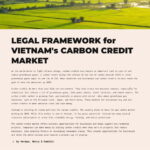INTRODUCTION
With our experience in advising Green Bond issuers, we present this Memorandum to provide a brief overview of certain aspects and considerations that issuers should be aware of and seek guidance on when contemplating and executing a Green Bond issuance.
1. Definition of Green Bonds
Green Bonds are similar to traditional bonds in that they are debt securities that are issued by companies to raise funds. However, the key difference is that Green Bonds are specifically designated to finance environmentally friendly projects, such as renewable energy, energy efficiency, sustainable agriculture, and clean transportation.
2. Benefits of Green Bonds for issuers
- Access to a broader investor base: Green Bonds can attract environmentally conscious investors and institutions with specific ESG (Environmental, Social and Governance) mandates, helping issuers diversify their funding sources.
- Competitive pricing: As demand for Green Bonds outpaces supply, issuers may potentially benefit from favorable pricing compared to conventional bonds.
- Reputation and corporate responsibility: Green Bond issuance can enhance an issuer’s reputation and demonstrate a commitment to sustainability and environmental stewardship.
3. Vietnam’s legal framework for Green Bonds
At present, Vietnam lacks a dedicated legal framework for Green Bonds. Nonetheless, the government has recently announced its commitment to implementing a roadmap for enhancing the legal framework, aimed at attracting green finance and technology while promoting green production and investment in the country.
CERTAIN ASPECTS AND CONSIDERATIONS
1. Main components of a Green Bond
The structure of a Green Bond is very similar to that of a traditional bond. However, there are a few key differences that make a bond “green”. Here are some of the main components of a Green Bond:
- Use of Proceeds: The issuer of a Green Bond specifies how the proceeds from the bond will be used. These funds are exclusively earmarked for financing environmentally-friendly projects or assets.
- Green Bond Framework: The issuer of a Green Bond creates or uses a “Green Bond Framework” which outlines the types of projects that will be financed with the bond proceeds, as well as the environmental standards that the projects must meet. The framework can be reviewed and verified by a third-party certification organization to ensure that the bond’s environmental impact is accurately reported.
- Reporting: The issuer of a Green Bond must report on the environmental impact of the projects that are financed with the bond proceeds. This reporting is typically done annually and can also be verified by a third-party certification organization.
- Issuer’s Environmental Performance: Some Green Bonds require the issuer to disclose their environmental performance metrics and goals to demonstrate their commitment to sustainability.
Overall, the structure of a Green Bond is designed to ensure that the bond proceeds are used to finance environmentally-friendly projects, and that the environmental impact of those projects is accurately reported to investors.
2. Types of Green Bonds
There are several different types of Green Bonds, each with its own unique features and characteristics. Here are some of the most common types of Green Bonds:
- Green Use of Proceeds Bonds: This is the most common type of Green Bond. The bond proceeds are exclusively used to finance environmentally-friendly projects or assets, as specified in the issuer’s Green Bond Framework.
- Green Project Bonds: These bonds are issued to finance a specific environmentally-friendly project, such as a wind farm or solar power plant. The bond’s repayment is typically linked to the project’s cash flows or performance.
- Green Securitized Bonds: These bonds are backed by a pool of assets that generate cash flows from environmentally-friendly projects, such as loans for energy-efficient buildings or renewable energy installations.
- Green Covered Bonds: These are similar to securitized bonds, but are typically backed by a pool of mortgages or other assets that finance environmentally-friendly projects.
Overall, the type of Green Bond that is issued will depend on the issuer’s financing needs, the type of projects being financed, and the preferences of investors.
3. Typical investors in Green Bonds
The typical investors in Green Bonds are diverse and can include a range of institutional and individual investors. Here are some of the most common types of investors in Green Bonds:
- Institutional Investors: This includes pension funds, insurance companies, asset managers, and other institutional investors that manage large pools of capital. These investors are often attracted to Green Bonds because they align with their mission or mandate to invest in environmentally-friendly projects or assets.
- Socially Responsible Investors: These investors are focused on investing in companies or projects that meet environmental or social criteria, in addition to financial criteria. Green Bonds are often considered a socially responsible investment because they finance projects that have a positive environmental impact.
- Retail Investors: This includes individual investors who purchase bonds through their brokerage accounts or other investment vehicles. Green Bonds may be attractive to retail investors because they offer the opportunity to invest in projects that have a positive impact on the environment.
- Development Banks: These institutions, such as the World Bank or European Investment Bank, invest in sustainable development projects in developing countries. Green Bonds can be an effective way for these institutions to raise capital to finance their sustainability initiatives.
Different types of investors in Green Bonds have different requests, concerns, and approaches based on a range of factors, including their investment objectives, risk tolerance, regulatory requirements, environmental and social priorities, and investment size. By understanding these differences, issuers of Green Bonds can better tailor their bond offerings to meet the needs and expectations of different types of investors.
4. Guarantors for Green Bonds
Guarantees for Green Bonds are not very common, but when they are used, they can be provided by a range of entities. Here are some of the typical guarantors for Green Bonds:
- Multilateral Development Banks: These institutions, such as the World Bank or Asian Development Bank, may provide a partial or full guarantee for a Green Bond issued by a developing country or private sector entity. The guarantee is typically used to enhance the creditworthiness of the issuer and provide investors with an additional level of comfort.
- Export Credit Agencies: These agencies provide insurance or guarantees to support the export of goods or services from a country. In some cases, they may provide guarantees for Green Bonds issued to finance the export of environmentally-friendly products or services.
- Insurance Companies: Insurance companies may provide guarantees for Green Bonds to enhance the creditworthiness of the issuer and provide investors with an additional level of comfort. They may also provide insurance policies to protect investors against the risk of default or other credit events.
- Banks: Banks may provide guarantees for Green Bonds issued by their clients to enhance the creditworthiness of the issuer and provide investors with an additional level of comfort. The guarantee may be provided by the bank’s own balance sheet or through a syndicate of banks.
The choice of guarantor will depend on the specific circumstances of the bond issuance and the preferences of the issuer and investors.
5. Escrow Account
Investors often request that issuers use an escrow account in Green Bond issuances to provide additional security and transparency for investor. An escrow account is a separate bank account that is established by the issuer of the Green Bond, and into which the bond proceeds are deposited. The funds in the escrow account are then released to the issuer once certain conditions have been met, such as the completion of the projects financed by the bond or the verification of the bond’s compliance with the Green Bond Framework.
While the use of an escrow account in Green Bond issuances can provide several benefits for investors and enhance the credibility of the bond offering, some issuers may be hesitant to use an escrow account for several reasons.
First, the establishment and maintenance of an escrow account can be costly and time-consuming for the issuer, as it requires additional legal and administrative work. Second, the use of an escrow account can limit the flexibility of the issuer to use the bond proceeds, as the funds can only be released once certain conditions have been met. Third, the establishment of an escrow account can create additional legal and regulatory requirements for the issuer, including the need to comply with banking regulations and reporting requirements.
To address these concerns, issuers and investors may need to negotiate the terms of the escrow account carefully, taking into account the costs and benefits of using an escrow account, as well as the preferences and requirements of both parties.
6. Strict Covenant Requirements
When investors in Green Bonds request that issuers commit to a range of strict and large covenants, including limitations or prohibitions on change of control, cross defaults, disposals, mergers, acquisitions, negative pledges, quasi-security, and change in business, they are often looking to protect their investment and ensure that the issuer is able to meet its obligations under the bond.
While some of these covenants may be common and reasonable, others can be too strict or even unreasonable. For example, limitations or prohibitions on change of control, mergers, or acquisitions can significantly limit the issuer’s ability to grow or expand its business, while negative pledges and quasi-security can restrict the issuer’s ability to borrow or secure other financing.
If issuers do not negotiate carefully to have qualifiers or exceptions included in these covenants, they may get into trouble later. For example, if an issuer enters into a merger or acquisition without first obtaining the necessary approval from the bondholders, it may be in default under the bond and subject to penalties or other consequences. Similarly, if an issuer breaches a negative pledge or quasi-security provision, it may be required to repay the bond immediately or be subject to other penalties.
To avoid these issues, issuers of Green Bonds should carefully review and negotiate all covenants with investors to ensure that they are reasonable and appropriate for the issuer’s business operations. This may involve seeking legal and financial advice to ensure that the covenants are structured in a way that provides sufficient protection for the investors while also allowing the issuer to operate and grow its business. Additionally, including qualifiers, carve-outs or exceptions in the covenants can provide some flexibility for the issuer while still meeting the requirements of the investors.
7. Specific Undertakings
Investors, especially development banks and socially responsible investors, are increasingly focused on the environmental and social impact of the projects they finance through Green Bonds. As a result, these investors may request that issuers of Green Bonds take representations and warranties and covenants that are specific undertakings in accordance with their operational policies related to environmental and social responsibilities. These requirements can be more complex than those for normal bonds. For example, a development bank may require an issuer to comply with the environmental and social safeguards policies of the bank, which can be more rigorous than the environmental and social standards required by local laws and regulations (this issue will be also mentioned below).
Issuers of Green Bonds should carefully consider the specific requirements of their investors and work to negotiate terms that meet the needs and expectations of both parties. This may involve working with legal and financial advisors who have experience in Green Bond issuances and are familiar with the specific requirements of different types of investors.
8. Environmental and Social Safeguards
Investors, especially socially responsible investors and development banks, often require issuers of Green Bonds to adopt an Environmental and Social Management System (ESMS) and comply with certain Environmental and Social Safeguards Policy and Framework, which is a framework for managing environmental and social risks associated with the projects financed by the bond, and can include processes for identifying and assessing risks, implementing mitigation measures, and monitoring and reporting on performance.
These policies and frameworks are often non-negotiable for investors, as they are critical to ensuring that the projects financed by the bond meet the investor’s environmental and social impact objectives. Therefore, issuers should assess whether they have appropriate systems and processes in place to implement and comply with such policies.
On the other hand, in some cases, issuers may be able to negotiate some flexibility in the implementation of these requirements. For example, an issuer may be able to negotiate a longer timeframe for implementing an ESMS, or may be able to propose alternative monitoring and reporting mechanisms that are better suited to their operations.
9. Reporting and verification
Reporting and verification are critical components of Green Bond issuances, as they provide transparency and assurance to investors that the bond proceeds are being used in a manner consistent with the environmental and social objectives of the bond.
Reporting typically involves regular disclosures by the issuer of the bond regarding the use of bond proceeds, the environmental and social impact of the projects financed by the bond, and other key performance indicators (KPIs) that are relevant to the investor’s environmental and social impact objectives. Reporting can be done through a variety of channels, including regular disclosures in financial reports or standalone sustainability reports, or through online platforms that allow for more frequent and detailed reporting.
Verification involves the independent assessment of the issuer’s compliance with the Green Bond Framework and other environmental and social standards. Verification can be done by third-party auditors or verifiers, who provide an independent assessment of the issuer’s compliance with the Green Bond Framework and other environmental and social standards. Verification can also be done by internal auditors or other stakeholders who provide an independent assessment of the issuer’s compliance with the Green Bond Framework and other environmental and social standards.
Green Bond issuers should carefully consider their reporting and verification obligations when issuing Green Bonds. They should work closely with their investors and advisors to establish a reporting and verification framework that meets the needs and expectations of all parties, and that provides transparency and assurance to investors that the bond proceeds are being used in a manner consistent with the environmental and social objectives of the bond. And, they should make sure that they have appropriate systems and processes in place to manage such process.
10. Greenwashing
Greenwashing occurs when an issuer of Green Bonds makes false or misleading claims about the environmental and social impact of the projects financed by the bond. To avoid the risk of being accused of greenwashing, issuers should negotiate closely and carefully with investors to ensure that the environmental and social impact of the projects financed by the bond are accurately represented and reported.
On the other hand, it is also important for issuers to have flexibility in using the bond proceeds. This flexibility can enable issuers to respond to changing market conditions and opportunities, and can ultimately lead to greater environmental and social impact.
To negotiate for flexibility in using bond proceeds, issuers can work closely with investors to understand their environmental and social impact objectives and to identify areas where flexibility may be appropriate. For example, an issuer may seek flexibility to allocate bond proceeds to a range of projects or to use bond proceeds for working capital or other general corporate purposes.
To achieve this flexibility, issuers may need to negotiate with investors to have certain restrictions or covenants relaxed or removed, or to have more discretion in how bond proceeds are allocated. This may involve developing specific reporting requirements or KPIs that demonstrate how the bond proceeds are being used in a manner consistent with the investor’s environmental and social impact objectives.







